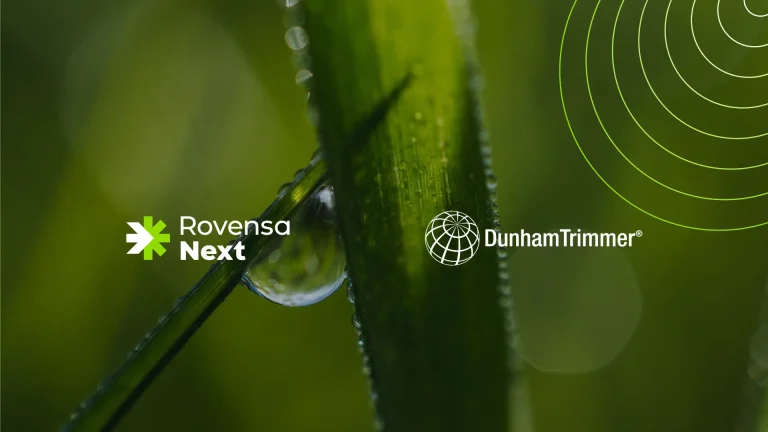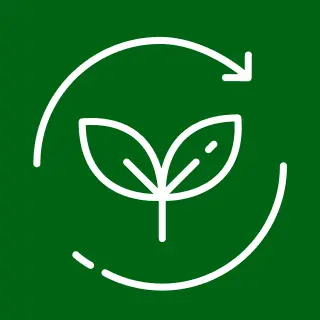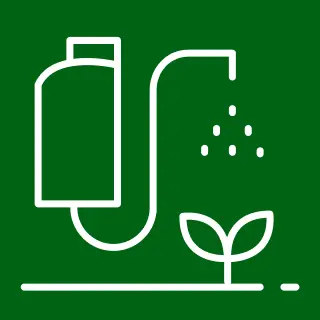At Rovensa Next, we recognize the urgent need to address these challenges and have developed innovative biosolution strategies to mitigate their impacts. Our solutions help combat abiotic stress and factors such as drought, floods, pests and disease, empowering farmers to take a holistic approach to protect their yields and adapt to extreme weather events.
Understanding La Niña and its agricultural impacts
La Niña is a recurring climate phenomenon characterized by a drop of at least 0.5 degrees Celsius in sea surface temperatures in the central and eastern tropical Pacific Ocean. It typically occurs every 2 to 7 years and lasts from 9 to 12 months, although it can sometimes last more than a year. These phenomena do not follow a regular pattern, unlike their counterpart, El Niño, which is defined by unusually warm ocean temperatures in the same region. La Niña often brings above-average rainfall to some regions and prolonged drought to others, exacerbating the challenges faced by agriculture. According to the FAO, these shifts in weather patterns heighten risks to food security, especially in vulnerable areas already struggling with resource management and production stability.¹
The World Meteorological Organization (WMO) further highlights La Niña‘s role in intensifying extreme weather events, underscoring its impact on global rainfall distribution and temperature anomalies.2
The latest forecasts from the WMO Global Producing Centres of Seasonal Prediction suggest that sea surface temperatures are expected to decrease, making Niña conditions more likely (55% chance) between December 2024 and February 2025, and from January to March 2025.3
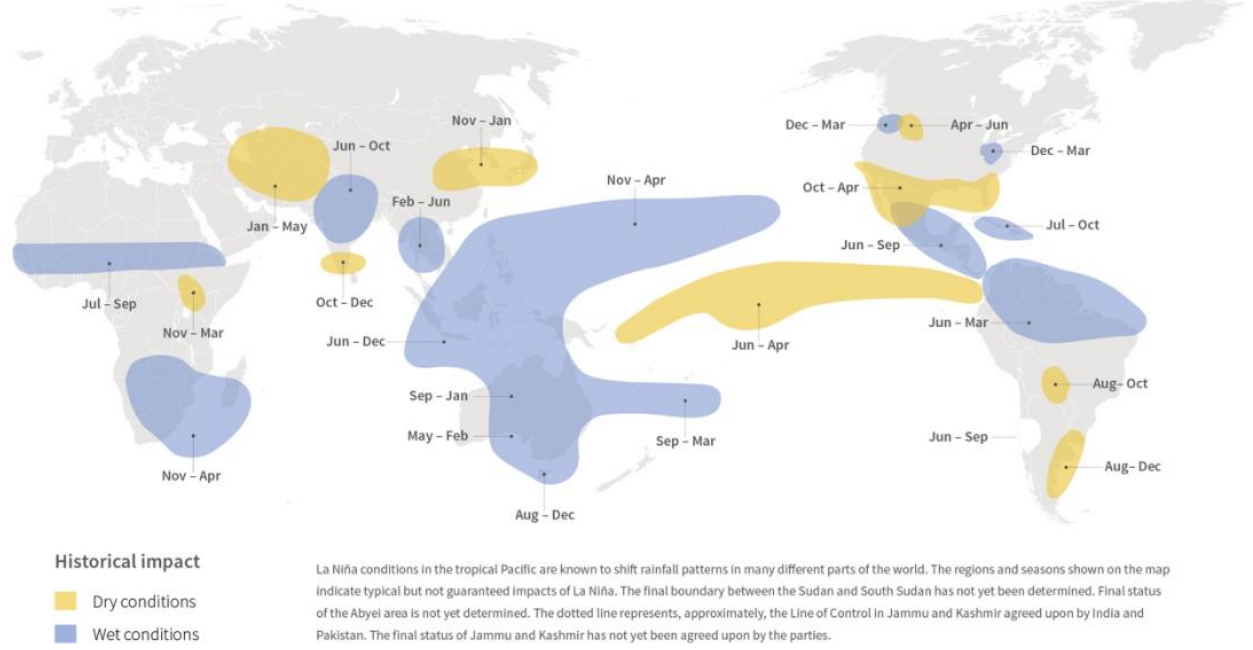
A broader perspective: aligned with climate and sustainability goals
Addressing the impacts of La Niña also aligns with global efforts to combat climate change and reach sustainability targets. Initiatives such as the United Nations Sustainable Development Goals (SDGs) and the European Green Deal underline the need for resilient agricultural systems that combine innovation and sustainable practices, while balancing productivity with environmental stewardship. These priorities are echoed in the IPCC’s recommendations for integrating climate resilience into agricultural frameworks, highlighting adaptive strategies as essential tools to mitigate environmental risks.5
At Rovensa Next, we offer a holistic portfolio of biosolutions designed to meet global challenges. Our approach combines innovative products with sustainable agricultural practices, addressing critical needs such as abiotic stress and integrated pest and disease management, among others. Our solutions, grounded in science and tailored to specific regional needs, range from bionutrition (including biostimulants and biofertilizers) to biocontrol and adjuvants.
Rovensa Next empowers farmers to enhance productivity, resilience, and environmental stewardship in agriculture by providing tools that mitigate the impacts of climate change.
The dual challenges of La Niña: flooding and drought
La Niña’s effects vary widely from one area to another:
- Regions prone to excessive rainfall and flooding. Countries such as Bangladesh, Vietnam, Mozambique, and Colombia often experience above-average rainfall during La Niña years. This leads to waterlogging, hypoxia (oxygen deficiency in soil), and increased risk of fungal diseases in crops. Flooding can also erode topsoil, washing away essential nutrients and reducing land productivity.
This is the case of farmers in Southeast Asia, who frequently report delayed planting schedules and reduced yields due to prolonged waterlogging in fields.
- Regions prone to drought. Conversely, areas such as Ecuador, Bolivia, and the Midwestern United States experience below-average rainfall, leading to severe drought. Drought stress not only reduces soil moisture but also limits photosynthesis, weakens root structures, and decreases plant resistance to pests.4
In 2022-2023, La Niña had a severe impact on Argentina, the world’s leading provider of processed soy meal and oil. La Niña triggered a drought that devastated the nation’s soy crop, resulting in the smallest harvest since the turn of the century.6
Holistic agronomic practices and biosolutions to tackle the challenges posed by La Niña
A holistic approach to mitigating the effects of La Niña involves combining agronomic practices with biosolutions to build resilient farming systems capable of withstanding climate extremes. Farmers can safeguard productivity and adapt to changing conditions by addressing soil degradation, water management, and pest and disease pressures.
- Soil conservation practices. Techniques such as no-till farming, cover cropping, and agroforestry help protect soil from erosion and enhance water retention capacity. Biosolutions such as Humistar WG, a humic acid-based biostimulant, that improves physical, chemical and biological soil characteristics, promoting better soil structure, root development, and improved nutrient availability. Another solution is Wiibio®, a biofertilizer with biostimulant properties, which enhances the positive effect of soil microbiome, creating better soil environment for root and plant development, contributing to improved nutrient availability and plant resilience to combat environmental stressors.
- Efficient water management: Uneven water distribution caused by La Niña makes irrigation efficiency a critical priority. Transformer optimizes water infiltration, distribution, and retention in drought-prone areas, ensuring effective use of water resources. Complementing this, Humistar WG, a humic and fulvic acid-based biostimulant, strengthens root systems, enhances water retention, and improves soil structure, helping crops withstand both waterlogging and drought conditions.
- Crop diversification and rotation. Planting a diverse range of crops with varying water and nutrient requirements reduces vulnerability to extreme weather events. Farmers can further support this strategy by using biostimulants to boost plant development, and biofungicides to prevent diseases associated with the increased humidity brought on by La Niña.
- Pest and disease management. The weather patterns brought by La Niña often lead to increased pest and disease pressures, requiring tailored approaches to ensure effective crop protection. Rovensa Next provides biosolutions that combine advanced technologies for sustainable pest and disease management.
Pyrethrin-based bioinsecticides such as Tec-Fort® and Santem® effectively control pests with minimal environmental impact. They degrade rapidly without harmful residues, making them ideal for integrated pest management (IPM). For fungal diseases, Bacillus subtilis-based biofungicides such as Portento®, Milagrum Plus®, and Ospo Vi55 ,offer preventive, curative action against powdery mildew, downy mildew, and other foliar diseases, reducing the reliance on conventional fungicides while ensuring rapid action and seamless compatibility. Rovensa Next OROWET® Technology enhances the efficacy of these solutions by optimizing the penetration and absorption of active ingredients, which are also present in orange oil-based biofungicides and bioinsecticides, providing a natural, multi-action approach to biocontrol.
The complexity of pest and disease dynamics means that integrated pest management strategies must be adapted to factors such as location, crop type, pest and disease prevalence, as well as local environmental conditions. Farmers are encouraged to contact their local Rovensa Next expert to identify and implement the most effective biosolutions for their specific circumstances.
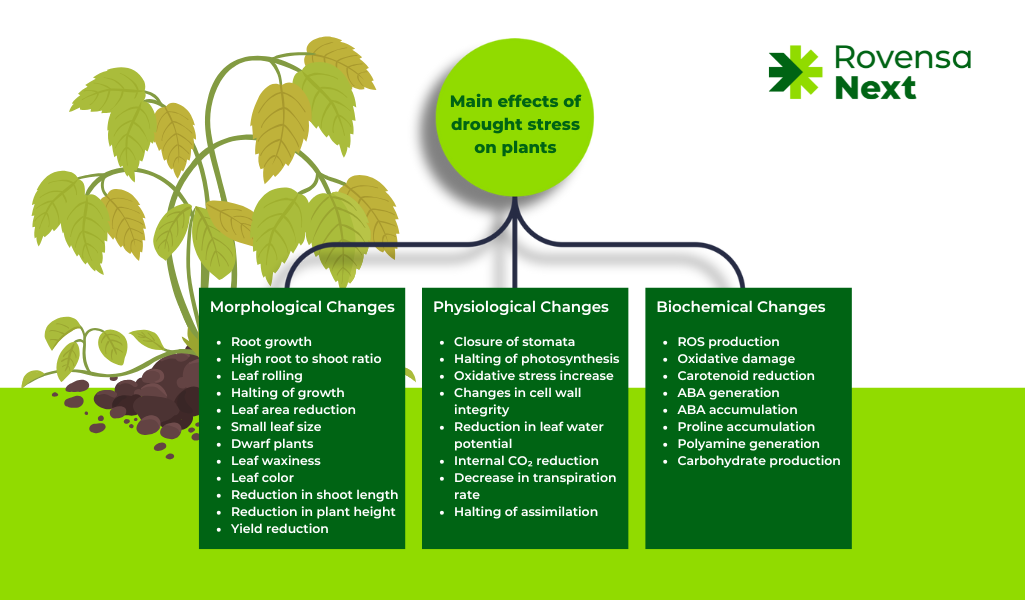
Addressing stress factors with holistic biosolutions approaches
Effective agronomic practices, such as efficient water management and soil conservation, are essential to mitigate the effects of abiotic stress on crop performance.
Without them, crops become more susceptible not only to environmental pressures but also to pest and disease outbreaks.
Farmers can strengthen plant resilience by combining these practices with innovative biosolutions, safeguarding crop health, development, and productivity against both abiotic and biotic challenges.
The way forward: turning challenges into opportunities
As La Niña is a global phenomenon, the consequences and prevalence of pests and diseases vary depending on the region and crop. At Rovensa Next, we support farmers through holistic biosolutions programs, offering tailored strategies that address specific crops and regional challenges. It is therefore essential to contact your local Rovensa Next expert to create a holistic biosolutions program tailored to your needs. Together, we can transform climate challenges into opportunities for resilience and sustainability, empowering farmers to lead the green transition.
Sources and references
- FAO: Anticipating the La Niña Phenomenon https://www.fao.org/newsroom/detail/fao-urges-swift-action-as-la-ni%C3%B1a-threatens-global-food-security/en
- World Meteorological Organization (WMO): La Niña and Global Weather Patterns https://wmo.int/resources/documents/el-ninola-nina-updates
- WMO: La Niña Update November 2024 https://wmo.int/files/el-ninola-nina-update-november-2024
- FAO: Climate Impacts on Agriculture and Food Systems: Understanding and Addressing the Effects of La Niña La Niña Anticipatory Action and Response Plan, September–December 2024
- IPCC: Agriculture and Climate Resilience https://www.ipcc.ch/report/ar6/wg2/
- BNN Bloomberg: La Niña Effects Surprise Argentine Farmers as Dryness Kicks In https://www.bnnbloomberg.ca/investing/commodities/2025/01/07/la-nina-effects-surprise-argentine-farmers-as-dryness-kicks-in/


